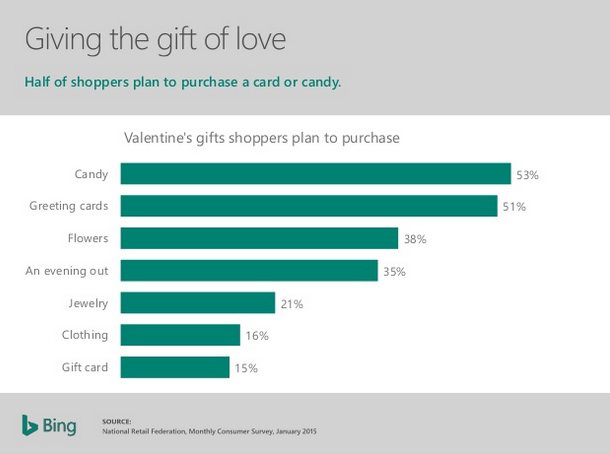What’s love got to do with Valentine’s Day?
Looking to woo consumers this Valentine's Day? Columnist Mona Elesseily shares insights from Bing Ads (and her own experience) to help your holiday ads flourish.

Traditionally, Valentine’s Day is a day for people in relationships to celebrate their love. But more and more, people who are not in committed relationships are making Valentine’s Day purchases. Clever marketers have caught on to this and are targeting other markets to boost overall Valentine’s Day sales.
In this article, I’ll cover other audiences marketers can focus on to boost Valentine’s Day sales and provide marketing tips to help you come out swinging with your Valentine’s Day advertising.
Data in this article is from two Bing Ads presentations: “Search Bing for Love: Valentine’s Day 2017 Insights for Digital Marketers” and “Valentine’s Day Insights to Woo Digital Marketers.”
Before getting started, here are some overall statistics on Valentine’s Day:
- Valentine’s Day is the fourth largest spending day of the year after the winter holidays, back to school and Mother’s Day.
- The average person spent approximately $150 on Valentine’s Day gifts in 2016.
- Approximately 55 percent of adults plan to celebrate Valentine’s Day.
- In 2016, Valentine’s Day spending was $19.7 billion dollars.
There are a few interesting trends happening around Valentine’s Day. They are:
1. Wider Valentine’s Day scope
Now more than ever, people are purchasing Valentine’s Day gifts for a number of different people in their lives. Here’s a breakdown of who people are buying for:
Here’s a breakdown of how much money people are planning to spend on each of the groups listed above in 2017:
- Significant other — $99
- Coworkers (is anyone from Page Zero Media reading this?!) — $54
- Family members — $50
- Classmates & teachers — $36
- Friends — $36
- Pets — $26
Believe it or not, 19 percent give gifts to their pets, and $681 million was spent on pets last year. Yeah, you heard me right!
My nieces buy for me, and I come up with special gifts (activity-based) for them. Valentine’s Day gift-giving is much broader than it used to be. The main takeaway here is to not get trapped into thinking the holiday is for a single specific group of people.
2. Singles on Valentine’s Day
Over half of Americans are single, and many choose to celebrate Valentine’s Day. Now more than ever, singles are purchasing gifts for a whole variety of reasons, and for many different people. Furthermore, Singles Awareness Day was created as a reaction to Valentine’s Day and is celebrated on February 15.
Some of the ways singles celebrate are getting together with single friends/family, treating themselves to special gifts or purchasing anti-Valentine’s Day gifts (see image below).
3. Relationships on Valentine’s Day
And, of course, there are the folks in committed relationships. Here’s the most interesting information I came across on people in this segment:
- 14 million people planned or expected a marriage proposal on Valentine’s Day. This figure is approximately 12 percent of single Americans. As such, engagement rings are the most searched jewelry item in the jewelry category.
- Only 21 percent of Valentine’s gifts shoppers plan to purchase jewelry (see graph below), but it generates the second-highest revenue around Valentine’s Day. Other jewelry-related searches (on mobile) include earrings, Pandora charms, Etsy and necklace.
- Most couples are more likely to choose gifts on their own without input from their significant other. This means people don’t always get what they want. The screen shot below shows what people want for Valentine’s Day vs. what they get. I find this useful, and it helps guide/inform my Valentine’s Day advertising spend.
Here are some useful Valentine’s Day advertising/marketing tips:
- Shoppers tend to spend less on non-significant others. So the tip here is to focus on affordable gifts if targeting consumers who are shopping for coworkers, family, pets and so on.
- Kick Valentine’s Day campaigns off in January to capture early shoppers and beat the Valentine’s Day rush. Valentine’s Day shopping ramps up in first two weeks of February, with clicks spiking between February 7 and February 14 (see graph below). Three out of 10 people buy gifts on Valentine’s Day, so continue full steam ahead with your budget on February 14. Continue advertising on February 15 if you to target Singles Awareness Day purchases.
- Focus advertising on the weekdays, as CPCs tend to be lower and CTRs higher (in my experience). As you know, many people shop between tasks/errands and so on on mobile devices, as opposed to carving out specific time to search for perfect gifts.
- Not only are people browsing/buying via mobile, but they’re sharing images via mobile to get input on gifts from friends and family. With this, it makes even more sense to have fast and well-optimized mobile sites.
- Ads selling gifts (not flowers or chocolate) perform well with superlatives (e.g., best, top, great), details on pricing and a solid call to action in ad copy.
- Repurpose holiday remarketing lists, as lists have been tested and just need to be refined for Valentine’s Day behaviors. Also, consider Valentine’s Day specific dynamic remarketing campaigns for shoppers who’ve interacted with specific products. We use both of these strategies to effectively increase lifetime value of customers.
- One of my latest tricks is the price drop feature (Bing). It detects a price change in the Bing feed and shows it in product ads. It’s a fantastic way to get your product ads some extra attention.
Happy Valentine’s Day!
Contributing authors are invited to create content for Search Engine Land and are chosen for their expertise and contribution to the search community. Our contributors work under the oversight of the editorial staff and contributions are checked for quality and relevance to our readers. The opinions they express are their own.
Related stories
New on Search Engine Land




